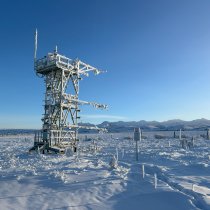Learning on the fly
June 19, 2012
By M. Johnson
I got a little nervous as I watched the first group of people disembarking the plane and saw one of my AOP team members carrying two little white bags. I’ve never had a weak stomach or gotten motion sickness, but I’d also never flown on such a small plane while having to watch a computer screen before, either. I really didn’t want to puke on the job. But how thrilling it was to finally be out in the field, ready to fly! Weaving through the planes in the hangar, watching the mechanics work, smelling the jet fuel – it was an exhilaratingly unfamiliar environment. I was excited to get up in the air, despite the possibility of needing to use a sick bag. Fortunately, through the turbulence and length of the seven flights I was on, my stomach proved to be unyielding! (Let’s hope it stays that way.)

Our inaugural flight campaign lasted about 3 weeks and started out in Grand Junction, Colo., because that’s where Twin Otter International is based. Tom, Nate, and Edwin went out a few days ahead of the rest of the team to integrate the system into the plane and get FAA approval. We were joined by a few of our JPL colleagues and the LiDAR guys from Optech to help with integration and flight operations. Our flights in this region consisted of operator training for, and various calibrations of, the LiDAR system; wiggle timing tests for the imaging spectrometer; and flights over areas we thought would give us some interesting data to process – including the Grand Mesa and an area in the San Juan mountains near Telluride. It was breathtaking to see these areas from above: the myriad of half frozen lakes on Grand Mesa, the vibrant red color and deep crevices of the Colorado National Monument, jagged snowcapped peaks, and the stark contrast between the natural arid landscape and the green patchwork fields of the local farms.
From there, we ferried out to Las Vegas to do some calibration flights for the spectrometer over Ivanpah Playa. We had planned for two cross-calibrations, one with AVIRIS Classic and one with Landsat7, in addition to our own calibration flight plans. Unfortunately, the ER-2 that AVIRIS was installed on had engine trouble and wouldn’t be fixed before we had planned to go home. Instead, we quickly put together a flight plan over Cuprite, Nev., a mineral mining area that has been used in other remote sensing studies. We may not have had the same kind of scenery on this leg of the trip, but we sure got our fair share of turbulence – that desert air moving over the hills can really throw the Twin Otter around! Since this was our first flight campaign, we knew that it was going to be a whale of a learning experience. It was the first time any of us would be operating instruments in the plane, and the first time ever running the LiDAR system (because it’s not something you can safely operate in the lab). We quickly learned the common problems and solutions for pre- and in-flight operations, as well as our personal limits while in flight (i.e. we need to keep some Dramamine on hand for a couple of our team members).
We also ran into a few slightly larger bumps in the road. In Grand Junction, we were grounded for two days due to an unexpected vacuum leak (a valve was completely missing an O-ring), and in Las Vegas we were delayed for half a day because the computer that controls the LiDAR system wouldn’t even boot up. We really had to roll with the punches on our final day of flights, a day that was planned to coincide with the Landsat 7 overpass, because we couldn’t connect to the IMU on the LiDAR system – which meant we couldn’t use our flight plans, and we couldn’t fire the laser. Luckily, 1) this was the day after the computer wouldn’t boot, so Nate had made sure I knew where to find the coordinates in the flight plan files in case we ran into a similar problem and 2) we had great pilots, Kerry and Cameron. We wrote out the starting and ending points for the pilots so they could enter them into their GPS by hand – Cameron was entering in the last points when we made it down to the playa, and we had about 20 minutes before the Landsat overpass. I wasn’t physically running an instrument on this flight but, in a way, I was running the plane. I told the pilots which lines to run, at what time, and at what altitude. In spite of the stress that accompanied this flight, it was successful – we got the data we wanted and needed for calibrations of the spectrometer. I learned a lot in the course of this campaign. Probably the most important lesson was that you can plan out the day’s flights down to the very last detail but you’ve still got to be flexible and work with whatever the day throws at you – whether it’s changing weather, computer problems, equipment malfunctions or cancelled plans. (A close second to this lesson is to make sure there are plenty of sick bags on the plane. I’m just saying, better safe than sorry.) Now that we’ve got a better idea what we’re up against in our future campaigns, I’m excited to get back in the plane in August out at the Harvard Forest site!



